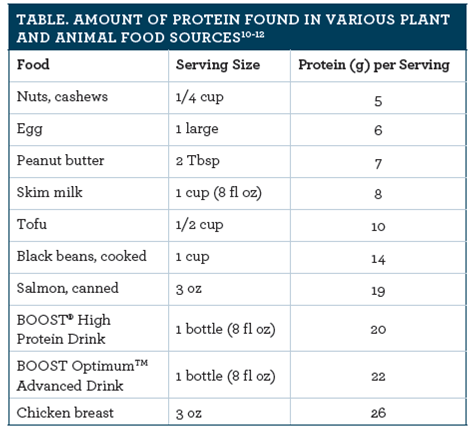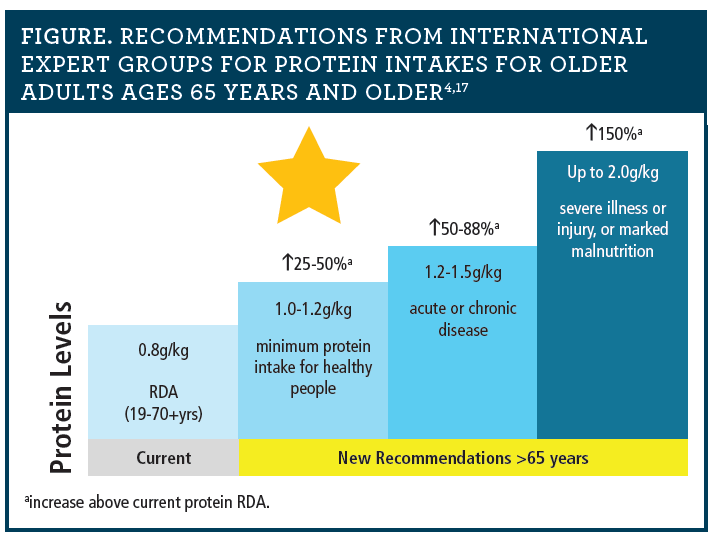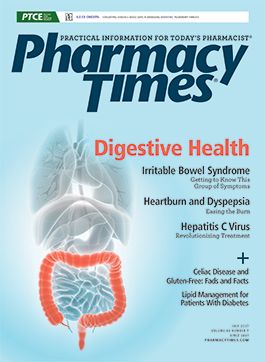Publication
Article
Pharmacy Times
Optimizing Protein Intake to Support Adult Health Considerations for Pharmacists
Protein is one of the essential nutrients needed in the human diet and is composed of individual building blocks known as amino acids.
Sponsored by Nestlé Health Science
Protein is one of the essential nutrients needed in the human diet and is composed of individual building blocks known as amino acids.1 Of the 20 amino acids that form protein in the human body, 9 are essential and can only be obtained through the diet.1,2 These essential amino acids are histidine, isoleucine, leucine, lysine, methionine, phenylalanine, threonine, tryptophan, and valine.1 The other 11 amino acids are nonessential because humans can make them.1,2 Unlike carbohydrates and fats, protein cannot be stored in the body; therefore, it is important to consume protein with each meal and snack to get the recommended amount of protein we need every day.2
FUNCTIONS OF PROTEIN IN THE HUMAN BODY
Protein forms the major structural components of all cells in the body. Protein is a component of enzymes, membranes, transport carriers, and hormones. Protein is required for the synthesis of neurotransmitters and serves as the key structural material that make up muscles, bones, hair, and nails. Finally, protein is also important in the function of immune cells, maintenance of fluid and acid-base balance, and in the transport of nutrients throughout the body (eg, hemoglobin is a protein that transports oxygen to all cells of the body).1
In addition to its roles in maintaining human health, evidence suggests that protein plays a key role in supporting healthy aging. As the body ages, skeletal muscle mass and function declines and muscle strength is lost. Known as sarcopenia, this condition is an important cause of age-related functional decline and loss of mobility.2 Strategies for sarcopenia management and prevention include exercising and maintenance of adequate nutrition.2 Furthermore, the optimization of protein intake has been shown to help promote wound healing, help support bone health, aid in weight management, and to help expedite recovery from illness or surgery after hospitalization.2-4 Additionally, protein is essential for recovery from falls and fractures, helps to preserve lean body mass, and stimulates muscle protein synthesis.4 Due to its diverse roles in the human body, protein is a dynamic and critical nutrient.5-7
SOURCES OF PROTEIN
Food sources of protein may be derived from either animal or plant sources. Animal sources of protein include chicken, pork, beef, fish, eggs, and dairy products such as milk, yogurt, and cheese. Plant sources of protein include soy, whole grains, nuts, and legumes. However, not all protein is created equal.1 High-quality proteins are considered complete proteins because they contain all the essential amino acids needed for health, whereas incomplete proteins lack one or more essential amino acids. In general, animal sources of protein are considered high quality, whereas most plant sources of protein are not; the exception is soy.1,8 Additionally, some whole grains, specifically quinoa, also contain all the essential amino acids needed for health, therefore making it a complete protein source.9 See TABLE10-12 for examples of the protein content of various foods and nutritional supplements.1,8

MEETING PROTEIN NEEDS IN HEALTHY ADULTS
For healthy adults (≥19 y), protein requirements are set by the Institute of Medicine through the Dietary Reference Intakes (DRIs). The DRIs represents a general term for a set of reference values including the acceptable macronutrient distribution range (AMDR) and the recommended dietary allowance (RDA). The AMDR for protein is set at 10% to 35% of energy for adults, meaning that 10% to 35% of daily calories should come from protein. The wide range in the AMDR suggests flexibility regarding exactly how much protein should be eaten in the context of a complete diet.13 The RDA represents the minimum daily dietary nutrient intake level sufficient to meet the nutrient requirements for 97% to 98% of all healthy individuals in a particular life stage and gender group. The RDA for protein for a healthy adult (≥19 y) is set at 0.8 g of protein per kg of ideal body weight per day.1,14 For example, the minimum protein needs of a healthy 50-year-old, 150-pound woman would be 54 g of protein per day ([150 lb/2.2 pounds per kg] × 0.8 g protein per kg).1
OVERVIEW OF INTERNATIONAL EXPERT GROUP RECOMMENDATIONS ON PROTEIN FOR OLDER ADULTS
Recommendations from international expert groups are calling for higher protein intakes for both healthy and non-healthy older adults (>65 y). Higher protein intakes for older adults may be beneficial in supporting positive health outcomes, such as promoting recovery from illness and maintaining functionality in older adults.4,14 Higher protein intake is also positively associated with higher bone mass density, slower rates of bone loss, and preservation of muscle mass and strength in this population.2,4,15,16 Many older adults have difficulty meeting protein intake targets from diet alone due to complications of acute or chronic conditions that reduce their ability to absorb and use available protein.4,17 This may increase risk for common age-associated problems such as sarcopenia, osteoporosis, and compromised immune function.1,2,16,18
According to international expert group recommendations, the benchmark for protein for healthy older adults is 1.0 g to 1.2 g of protein per kg of body weight per day.4,17 For example, the minimum protein needs of a healthy 65-year-old, 150-pound woman would be 68 g of protein per day ([150 lb/2.2 pounds per kg] x 1.0 g protein per kg). Older adults with acute or chronic diseases should maintain slightly higher intake levels of 1.2 g to 1.5 g of protein per kg of body weight per day.4,17 Among those with severe illness, injury, or marked malnutrition, international expert groups recommend 1.5 g to 2.0 g of protein per kg of body weight per day (FIGURE4,17).4,17

Data from the 2013-2014 National Health and Nutrition Examination Survey (NHANES) reveals that men and women of all ages have an opportunity to increase protein consumption based on the percentage of total calories (up to 35% of total calories may be sourced from protein).5,19 Research published by Paddon-Jones and Leidy suggests that older adults should consume approximately 20 g to 35 g of protein per meal to maximize protein synthesis and enhance preservation of muscle mass over time, particularly in patients suffering from sarcopenia.2,14,20 Because it is difficult to maintain a high daily intake of protein, nutritional drinks that are rich in protein can help augment protein intake in older adults to promote healthy living.2,5,14,19,20
Individuals with a variety of health conditions may also benefit from the use of nutritional drinks. These include patients who are receiving chemotherapy, patients who are recovering from falls or fractures, weight management patients, adults who are at risk for malnutrition or are currently malnourished, adults with diabetes seeking strategies to augment protein intake, and adults recovering from illness, recent hospitalization, or surgery.2,17,21-23
ROLE OF THE PHARMACIST
Pharmacists serve an important role in advising patients on a variety of nutritional products. Pharmacists can communicate the potential benefits of optimal protein intake for older adults, particularly those with chronic disease. Higher protein intake in older adults is associated with improved health outcomes, including a lower risk of bone fractures, continued support and maintenance of muscle tissue function, and improved outcomes following hospitalization or major surgical procedures.1,2,4,15-18,24
To help patients achieve adequate intakes of protein, pharmacists may recommend protein-augmented nutritional drinks to appropriate patients, or caregivers of patients, such as BOOST® Nutritional Drinks. These products can help patients achieve optimal protein intake levels to support long-term health and achieve dietary goals.
References
1. Institute of Medicine. Dietary reference intakes for energy, carbohydrate, fiber, fat, fatty acids, cholesterol, protein, and amino acids (macronutrients). Washington, DC: National Academies Press; 2002/2005. https://www.nap.edu/read/10490/chapter/1. Accessed March 23, 2018.
2. Arentson-Lantz E, Clairmont S, Paddon-Jones D, et al. Protein: a nutrient in focus. Appl Physiol Nutr Metab. 2015;40(8):755-761. doi: 10.1139/apnm-2014-0530.
3. Bonjour JP. The dietary protein, IGF-I, skeletal health axis. Horm Mol Biol Clin Investig. 2016;28(1):39-53. doi: 10.1515/hmbci-2016-0003.
4. Bauer J, Biolo G, Cederholm T, et al. Evidence-based recommendations for optimal dietary protein intake in older people: a position paper from the PROT-AGE Study Group. J Am Med Dir Assoc. 2013;14(8):542-559. doi: 10.1016/j.jamda.2013.05.021.
5. National Academies of Science. Dietary references intakes: macronutrients. www.nationalacademies.org/hmd/~/media/Files/Activity%20Files/Nutrition/DRI-Tables/8_Macronutrient%20Summary.pdf. Accessed March 23, 2018.
6. Timmerman KL, Dhanani S, Glynn EL, et al. A moderate acute increase in physical activity enhances nutritive flow and the muscle protein anabolic response to mixed nutrient intake in older adults. Am J Clin Nutr. 2012;95(6):1403-1412. doi: 10.3945/ajcn.111.020800.
7. Watson JD. Sarcopenia in older adults. Curr Opin Rheumatol. 2012;24(6):623-627. doi: 10.1097/BOR.0b013e328358d59b.
8. Richter CK, Skulas-Ray AC, Champagne CM, Kris-Etherton PM. Plant proteins and animal proteins: do they differentially affect cardiovascular disease risk? Adv Nutr. 2015;6:712-728. doi: 10.3945/an.115.009654.
9. Vega-Gálvez A, Miranda M, Vergara J, Uribe E, Puente L, Martínez EA. Nutrition facts and functional potential of quinoa. J Sci Food Agric. 2010;90(15):2541-2547. doi: 10.1002/jsfa.4158.
10. USDA National Nutrient Database for Standard Reference Release 28 2016. USDA website. https://ndb.nal.usda.gov/ndb/. Accessed March 23, 2018.
11. Nestlé Health Science. Data on file.
12. Nestlé Health Science. BOOST Optimum Advanced Drink nutrition information. https://www.boost.com/products/optimum. Accessed March 23, 2018.
13. Wolfe RR, Cifelli AM, Kostas G, Kim IY. Optimizing protein intake in adults: interpretation and application of the recommended dietary allowance compared with the acceptable macronutrient distribution Range. Adv Nutr. 2017;8(2):266-275. doi: 10.3945/an.116.013821.
14. Paddon-Jones D, Leidy H. Dietary protein and muscle in older persons. Curr Opin Clin Nutr Metab Care. 2014;17(1):5-11. doi: 10.1097/MCO.0000000000000011.
15. Rapuri PB, Gallagher JC, Haynatzka V. Protein intake: effects on bone mineral density and the rate of bone loss in elderly women. Am J Clin Nutr. 2003;77(6):1517-1525.
16. Hannan MT, Tucker KL, Dawson-Hughes B, Cupples LA, Felson DT, Kiel DP. Effect of dietary protein on bone loss in elderly men and women: the Framingham Osteoporosis Study. J Bone Miner Res. 2000;15(12):2504-2512. doi: 10.1359/jbmr.2000.15.12.2504.
17. Deutz NE, Bauer JM, Barazzoni R, et al. Protein intake and exercise for optimal muscle function with aging: recommendations from the ESPEN Expert Group. Clin Nutr. 2014;33(6):929-936. doi: 10.1016/j.clnu.2014.04.007.
18. Chernoff R. Protein and older adults. J Am Coll Nutr. 2004;23(suppl 6):627S-630S.
19. U.S. Department of Agriculture, Agricultural Research Service. 2016. Energy Intakes: Percentages of Energy from Protein, Carbohydrate, Fat, and Alcohol, by Gender and Age, What We Eat in America, NHANES 2013-2014.
20. Baugreet S, Hamill RM, Kerry JP, McCarthy SN. Mitigating nutrition and health deficiencies in older adults: a role for food innovation? J Food Sci. 2017;82(4):848-855. doi: 10.1111/1750-3841.13674.
21. Promislow JH, Goodman-Gruen D, Slymen DJ, Barrett-Connor E. Protein consumption and bone mineral density in the elderly: The Rancho Bernardo Study. Am J Epidemiol. 2002;155(7):636-644. doi: 10.1093/aje/155.7.636.
22. Dong JY, Zhang ZL, Wang PY, Qin LQ. Effects of high-protein diets on body weight, glycaemic control, blood lipids and blood pressure in type 2 diabetes: meta-analysis of randomised controlled trials. Br J Nutr. 2013;110(5):781-789. doi: 10.1017/S0007114513002055.
23. Demling RH. Nutrition, anabolism, and the wound healing process: an overview. Eplasty. 2009;9:e9.
24. Sahni S, Broe KE, Tucker KL, et al. Association of total protein intake and with bone mineral density and bone loss in men and women: the Framingham Offspring Osteoporosis Study. Public Health Nutr. 2014;17(11): 2570-2576. doi: 10.1017/S1368980013002875.







